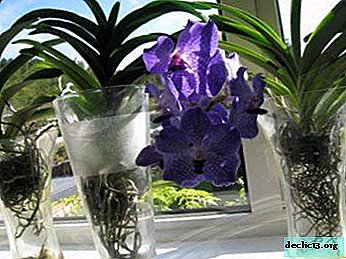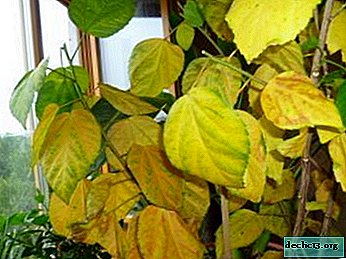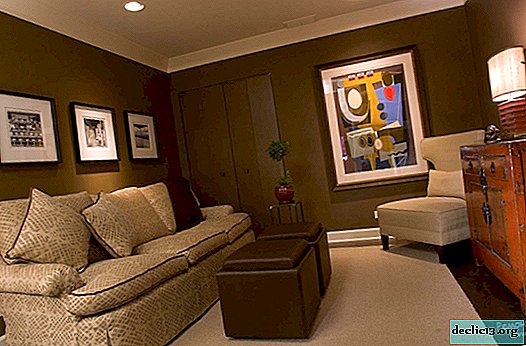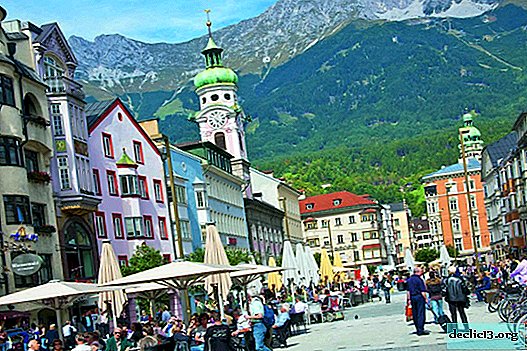The tenderness of white inflorescences - euphorbia Mountain snow: growing from seeds and cuttings, caring for the plant
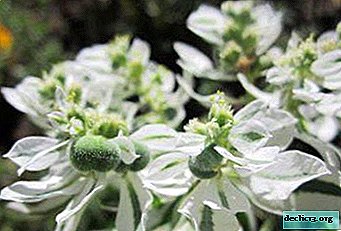
Euphorbia marginata is the most refined and delicate variety among the vast family of the Euphorbia family. It blooms luxuriantly and generously, a hardy and unpretentious flower is usually planted as a background plant in flower beds with roses, phlox, dahlias.
From this article, both amateur gardeners and experienced gardeners will be able to find out everything about this plant: watering, care, reproduction, pruning and much more. Photos of euphorbia are also presented to flower lovers.
Botanical Description
Euphorbia mountain snow - annual. In nature, grows on the slopes of mountains in North America. The scientific name is euphorbia marginata, but due to the nature of the colors of the leaves, this species has many names - fringed, mountainous, snow in the mountains, rock crystal, rich bride, etc.
An adult sprawling bush grows to 70 - 80 cm, branches well. In spring, the leaves are grayish-green, up to 5 cm in length. Oval, may be pointed or rounded in shape, depending on the variety variety. As soon as a bush blooms in mid-summer, the leaves change color - a snow-white border appears.
Important! Even after flowering, until mid-autumn, the flower retains the decorative appearance of leaves, dies only after the first frost.The flowers are small, located on the tops of the stems - shoots. Forms lush caps of white inflorescences in June - July. The variety is characterized by growth intensity, generosity of flowering. The root is powerful, vertical, creeping. Grain seeds, ripen in September, the variety is capable of propagating by self-sowing.
Photo
Looking at the photo, it becomes clear why this flower is popularly called Snow on the mountain:




How to care for Euphorbia marginata?
Temperature
Euphorbia mountain snow is a very heat-loving variety. It tolerates summer heat. The optimum growth temperature is 20 - 25 ° C. Desired humidity level is 40 - 45%.
Watering
Thanks to the branched root, the spurge fringed is quite resistant to drought. Watering is recommended moderate, as the topsoil dries. No additional spraying required.
The plant does not tolerate wet, swampy substrate, with excessive moisture, the risk of damage by putrefactive bacteria increases. You can not plant bushes near groundwater and water bodies.
Shine
Very photophilous variety, for planting requires sunny places.
From a lack of sun, the leaves lose their snow-white expressive diversity. They become faded, fade. The bush itself is poorly branched, elongated, flowering is delayed, inflorescences become rare and dull.
Pruning
When growing seedlings, it is advisable to pinch seedlings to form a lush bush. Before and after flowering, euphorbia mountain snow does not require additional pruning. In late autumn, the leaves are cut, the root processes from the site are removed.
Attention! The flower is very poisonous, therefore, all manipulations are recommended to be carried out in garden gloves, juice must not be allowed to enter the eyes and skin.Top dressing
Euphorbia marginate grows well in ordinary garden soil, timely weeding of weeds and regular cultivation of the substrate is required. In the period of active growth, you can make complex mineral fertilizers or organics. Fertilizer is best applied after sunset when watering.
Pot
The flower is unpretentious. Planting containers can be selected from any material. Pots or containers should be spacious and deep enough for free root placement and good breathability.
Watch the video about plant care and planting:
Breeding
Seeds
Growing from seeds is a very convenient way to propagate milkweed mountain snow. Seeds germinate quickly, practically do not get sick, seedlings develop well and quickly.
You can sow immediately in open ground, in the winter. Sowing is carried out in mid-May, when the threat of morning frost passes. But sowing immediately into the soil is possible only in the southern regions.
The scheme of planting seeds in open ground:
 The site is dug up, weeds are removed.
The site is dug up, weeds are removed.- Narrow holes are dug 6-7 cm deep at a distance of 30 - 35 cm from each other.
- At the bottom of each well, it is advisable to place some pebbles for drainage.
- Wells are well moistened.
- In each well, 1-2 seeds are determined.
- Sprouts usually appear in 10 to 12 days.
Sick and weak shoots are rejected immediately.
For better germination and fortress seedlings, experienced growers recommend growing seedlings at home. Sowing is carried out in February - early March.
The procedure for planting seeds is simple:
- For sowing, use a small, wide tank.
- At the bottom of the container, it is desirable to lay out a small drainage layer of expanded clay.
- A layer of garden fertile soil up to 5-6 cm high is poured on top.
- Large seeds - grains are pressed into the soil to a depth of 3-4 cm.
- The seed container is set in a warm, bright place.
- The temperature of the seed content is 20 - 22 ° C.
- Watering is moderate.
- Seeds germinate within 5 to 7 days.
- After 2 to 3 leaves appear on the seedling, they must be dived into special pots or glasses.
- In April - May, seedlings can be planted on a flower bed or in a flower garden.
- The distance between the planting holes is at least 25-30 cm.
- When diving and transplanting seedlings into the open ground, an old earthen lump should be preserved so as not to damage the root processes.
Cuttings
This method is usually not used for mass plantings on a flower bed. But in isolated cases it is possible to carry out cuttings.
Cuttings for propagation are taken only from adult bushes.
Milkweed cuttings of mountain snow root perfectly, you should consider some of the features of the cuttings:
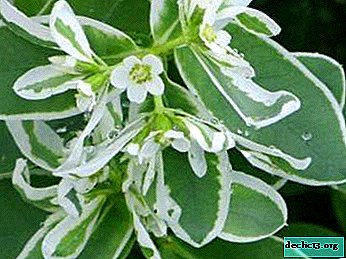 A small branch 6 to 7 cm long is cut.
A small branch 6 to 7 cm long is cut.- The shank is lowered into warm water to stop the flow of juice.
- The cuttings are dried, within 20-24 hours the cuttings are dried in the shade.
- Next, the cuttings are planted in a special mixture.
- Rooting takes place within 3 to 4 weeks.
- The air temperature for rooting cuttings is 22 - 25 ° C.
- Seedlings are transferred to planting containers or pots. You can plant directly in the flowerbed.
Soil mixture for rooting cuttings:
- Peat - 1 hour
- Sand - 1 hour
- Garden land - 2 hours
- Drainage layer.
Division
You can also propagate euphorbia mountain snow by dividing the bush. The method is painless, adaptation and rooting to new conditions is quick.
Important! The method is used for transplantation, parts of an adult healthy root are separated.The division procedure is carried out in the spring.:
- The soil of the mother bush is well moistened.
- An adult bush is being dug up.
- Sick and dry root processes are removed.
- In each part there should be processes of the root along with the stem.
- Separated parts are planted in containers or immediately in flower beds.
- When dividing, it is desirable to maintain an earthen lump for the successful rooting of a seedling.
- Watering is moderate.
Flower Diseases
The variety is distinguished by endurance and resistance to diseases and garden pests. Watering is necessary only in a dry summer.
Watering is carried out under the root, water should not get into leaf sockets. Stem and root diseases may appear - milk, gray rot. The flower does not tolerate dampness and excessive moisture, powdery mildew, mosaic viruses may appear on the leaves.
It is also not recommended to plant bushes in shady places, from a lack of light the bushes wither and die.
Euphorbia mountain snow not only decorates flower beds, rockeries and flower beds. Experienced gardeners specially plant this flower around the perimeter of the plot, along the beds - it perfectly guards the garden from rodents and moles.

 The site is dug up, weeds are removed.
The site is dug up, weeds are removed. A small branch 6 to 7 cm long is cut.
A small branch 6 to 7 cm long is cut.




